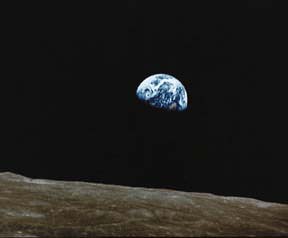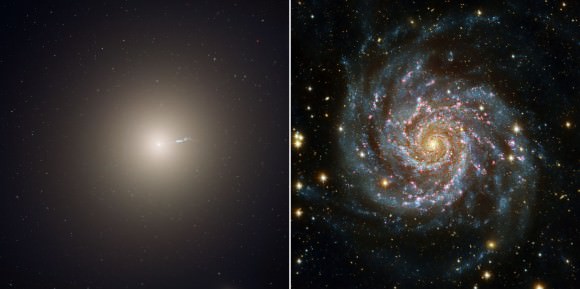If you could stand on the Moon and look back at the Earth, what would you see? How would it compare from our familiar vantage point?
We know what the Moon looks like from Earth, but what would the Earth look like from the Moon?
Pretty strange, actually.
The Moon is tidally locked to us, and it presents only one face to the Earth.
If you were on the near side of the Moon, the Earth would always be in the sky. And if you were on the far side, you’d never see it.
Also, it’s weird there. So you’d probably want to move.
If you were standing on the Moon, looking up, you’d see the Earth, hanging in the sky forever, or for however long your robot body holds out.
It would go through phases, like the Moon, moving from total darkness, though quarter illumination, Full Earth, and back again. But the features on the Earth would be changing. The face of the Earth would be illuminated, and you’d see the entire planet turning throughout the day and you could use it to cheat on Geography tests.
It wouldn’t be totally dark on the night side because “humans”. You’d see those beautiful blobs of stringy light on the shadowed parts of the Earth.
Our Moon follows an elliptical path around the Earth, getting as close as 363,000 km and as far as 405,000 km.
This means the Earth would get bigger and smaller in the sky. As Earth is much larger than the Moon, it would take up 13 times as much area.
The Earth wouldn’t actually hang motionless in the sky. We see lunar libration from our perspective, which lets us peek around the corner of the Moon. But from the Moon, we’d see the Earth move back and forth in the sky over 27 days.

Remember this famous Earthrise photo captured by Apollo 8? It’s on every single sales brochure for lunar real estate.
Don’t be fooled, if you were on the Moon, you’d never see an Earthrise like that.
In fact, the only way to get a view like that is be on a spacecraft orbiting the Moon.
If I lived on the Moon, I’d want property Earthside.
Would you like to see the Earth from the Moon? What other views of the Solar System would you like to get?
And if you like what you see, come check out our Patreon page and find out how you can get these videos early while helping us bring you more great content!



